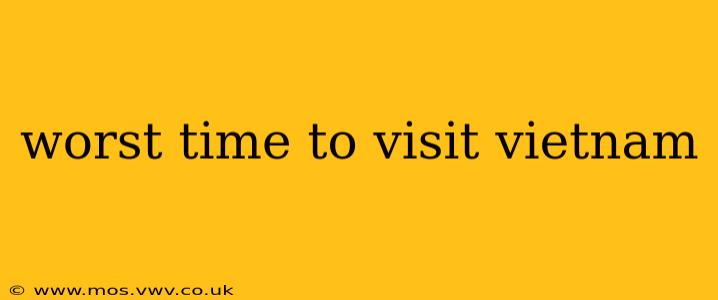Vietnam, with its stunning landscapes, vibrant culture, and delicious cuisine, is a popular travel destination. However, understanding the country's diverse climate is crucial for planning the perfect trip. While Vietnam is beautiful year-round, certain times offer less-than-ideal conditions. This guide will help you determine the worst time to visit Vietnam based on weather patterns and potential travel disruptions.
What are the wet and dry seasons in Vietnam?
Vietnam's climate varies significantly depending on the region and altitude. Generally, the country experiences two main seasons: a dry season and a wet season. The dry season, typically lasting from November to April, brings sunshine and lower humidity, making it a popular time to visit. The wet season, from May to October, features higher rainfall and humidity, though the intensity varies considerably depending on location and time of year.
When is the typhoon season in Vietnam?
Typhoon season in Vietnam typically runs from July to November, with the peak months being August and September. These storms can cause significant disruption to travel plans, including flight cancellations, flooding, and road closures. While typhoons aren't a guaranteed occurrence, the risk increases dramatically during these months. This is a key factor in determining the worst time to visit.
What is the hottest time to visit Vietnam?
The hottest time to visit Vietnam is generally from March to May, especially in the central and southern regions. Temperatures can soar, and the humidity can be oppressive. This intense heat can make outdoor activities uncomfortable, and the strong sun poses a higher risk of sunburn.
How does the weather affect travel during different times of year?
The weather significantly impacts various aspects of travel in Vietnam:
- Transportation: Heavy rainfall and flooding during typhoon season can disrupt road and rail travel, while strong winds can affect flights.
- Outdoor Activities: Hiking and other outdoor activities are less enjoyable during the hottest and wettest periods.
- Sightseeing: Heavy rain can limit your ability to explore certain sites comfortably.
- Crowds: The dry season, particularly around holidays like Tet (Lunar New Year), sees a surge in tourists, leading to higher prices and more crowded attractions.
What months should I avoid visiting Vietnam?
Based on the factors above, the worst time to visit Vietnam is generally September and October. These months fall within both typhoon season and the wet season, leading to a higher likelihood of severe weather disruptions. July and August also have a high risk of typhoons. While the wet season extends to November, the likelihood of typhoons diminishes.
Is it possible to have a pleasant trip during the wet season?
Yes, absolutely! The wet season isn't necessarily a total washout. Rainfall often comes in short, intense bursts, leaving many hours of sunshine. However, be prepared for occasional downpours and pack accordingly with waterproof clothing and sturdy footwear. Prices are generally lower during the wet season, and tourist crowds are less dense.
Are there any advantages to visiting during the wet season?
Despite the challenges, visiting Vietnam during the wet season offers some advantages:
- Lower prices: Accommodation and flights tend to be cheaper.
- Fewer crowds: Tourist attractions are less congested.
- Lush landscapes: The abundant rainfall creates incredibly vibrant and lush landscapes.
- Unique experiences: You might experience cultural events and festivals specific to the wet season.
Ultimately, the "worst" time to visit Vietnam is subjective and depends on your priorities and tolerance for certain weather conditions. By understanding the seasonal patterns and potential impacts, you can make an informed decision and plan a trip that aligns with your preferences.
